Amanita 'farinosa PNW04'
-
This grey, powdery Amanita with little evidence of a volva or
partial veil (making it easily confused with section Vaginatae) is in a
different subsection than all the other PNW section Amanita species, and
you could argue it is unique enough to deserve its own section. The real
Amanita farinosa from Europe and/or Eastern North America is slender and the
cap is striate. Our west coast species, also called A. farinosa sensu Thiers
but in need of a new name, is stockier
and therefore does not have many striations in the cap (striations
usually come from thin flesh allowing the outline of the gills to be visible
near the rim of the cap). Even though we don't have reliable DNA of the "real"
A. farinosa to compare with, it is universally accepted that our DNA is
going to be different because our species is unique.
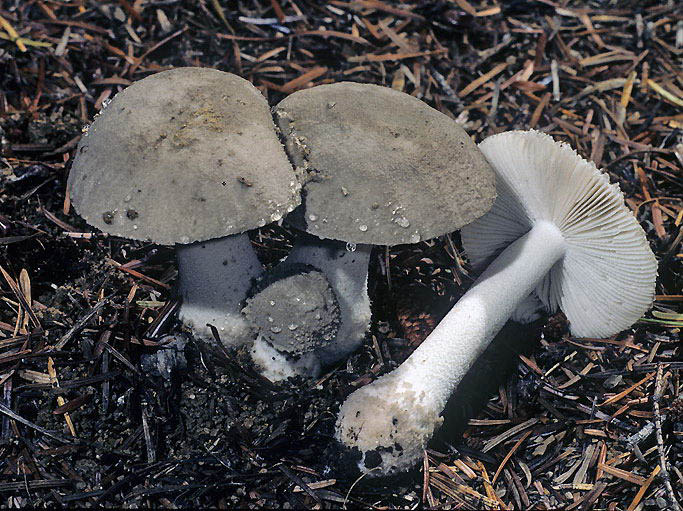
Amanita 'farinosa PNW04' © Kit Scates Barnhart
Amanita muscaria EU
Amanita 'muscaria PNW03'
Amanita chrysoblema MI (Amanita muscaria
EU misapplied)


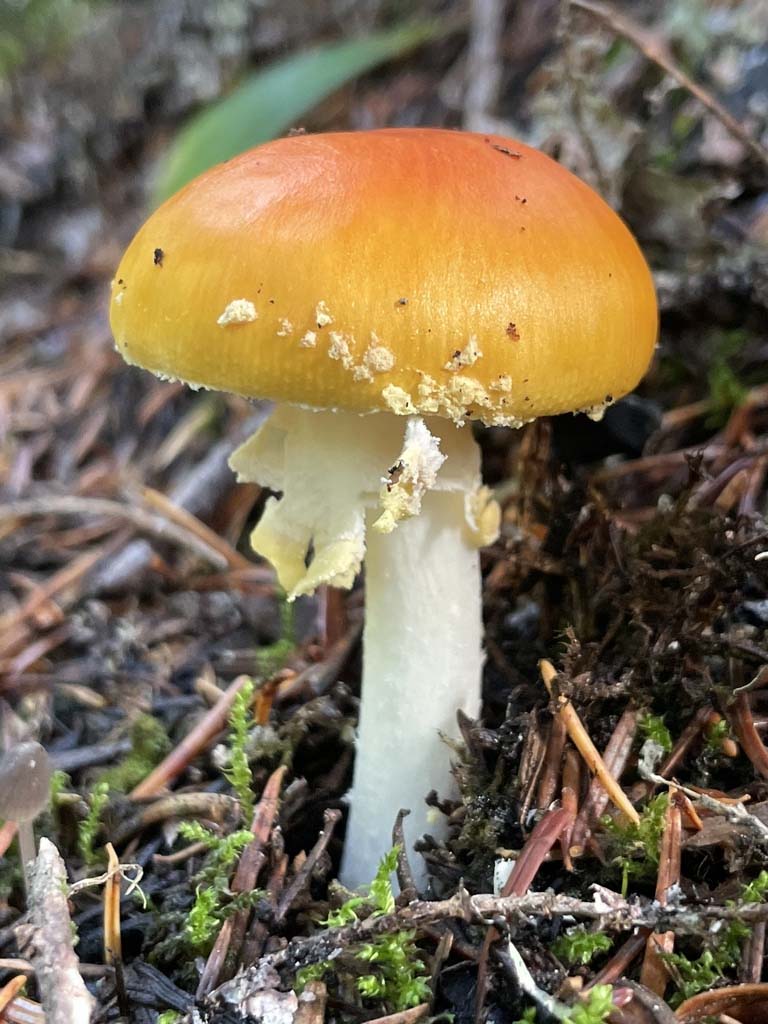
Amanita muscaria (red cap, white warts, European photo) © iNaturalist user naomimoriyama1, Amanita
'muscaria PNW03' © Alice Kam and Yi-Min Wang
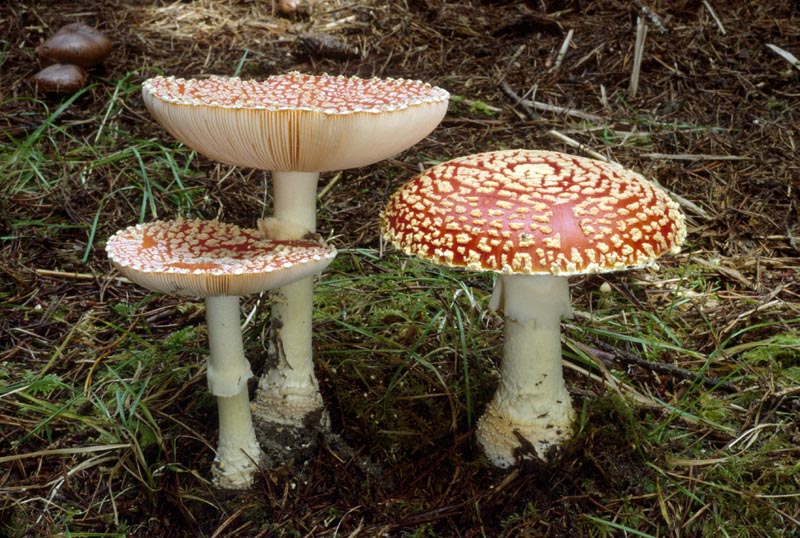
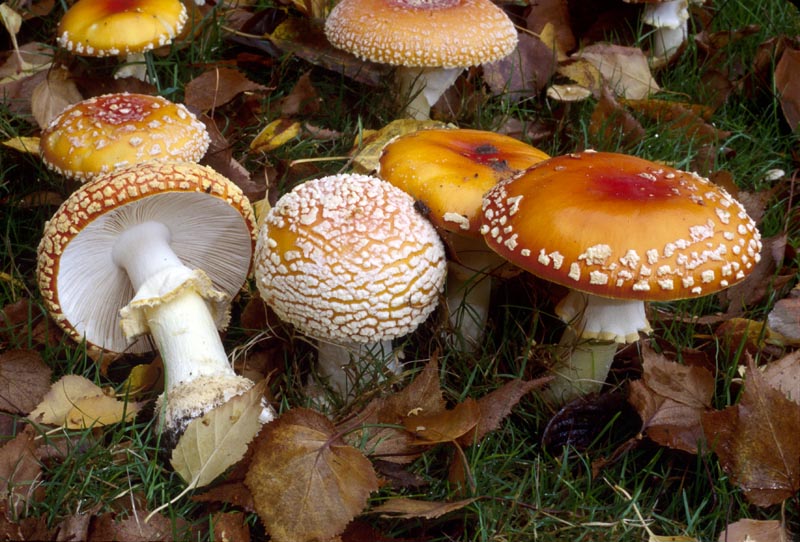
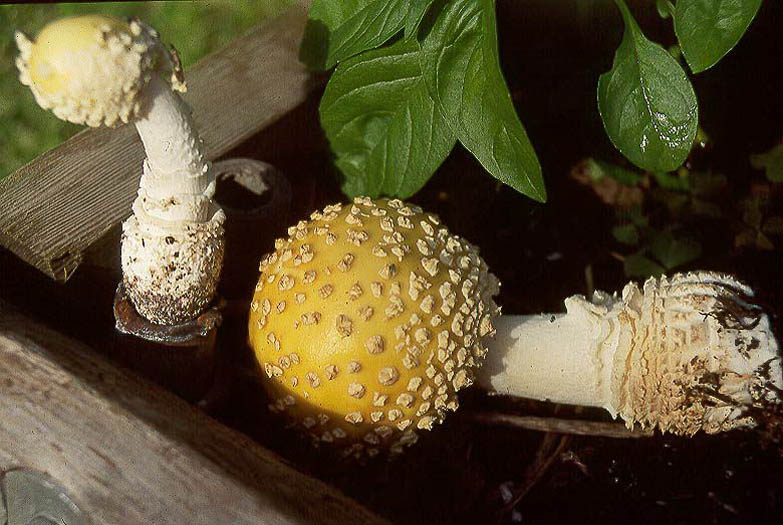

Amanita chrysoblema (red, orange, yellow, and white forms) © Steve Trudell,
Steve Trudell, Janet
Lindgren, and Steve Trudell
These are the famous Alice In Wonderland/Mario Brothers mushrooms with
colourful caps (red, orange, yellow or white) with pale, removable warts
on the caps from the universal veil, or "egg" that the mushroom appears to hatch
out of. They have a series of concentric rings as a volva near the base
of the stem.
Read this paper by Geml
more more information about the discussion below.
Amanita muscaria EU -
Geml clade II - the
true Amanita muscaria is
uncommon in the PNW, usually found under
introduced trees with almost pure white warts. It is found
commonly across Europe and Asia and Alaska, but uncommonly has been found (so
far) as far south as Vancouver BC. Unlike our common local species, discussed
next, the real Amanita muscaria is usually red. European
literature seems to speak of non-red colours, like the yellow A. muscaria
var. formosa EU, only rarely. I would
be interested in sequences of non-red actual Amanita muscaria picked locally.
Keep reading.
Amanita 'muscaria PNW03' -
Geml clade II/A - only in the PNW do we so far find some sequences that
differ by 4 bp in ITS from all the rest of the true Amanita muscaria found worldwide.
Like A. chrysoblema below, it differs in being with native trees,
having yellowish warts, and it can come in red, orange or yellow
(so far, and presumably white). It may have a white or coloured partial veil. Could this be A. muscaria var.
formosa EU? That is a yellow form but I cannot verify that this sequence is
found in Europe since the close proximity to A. muscaria (4 bp) makes it
hard to research. Also, PNW03 is not always yellow. It seems to clearly be distinct
from var. muscaria, but I have
no idea how to tell it apart from the far more abundant A. chrysoblema,
described next.
Amanita chrysoblema MI (Amanita
muscaria misapplied) - Geml clade I - a lookalike of 'muscaria
PNW03' found throughout NA, our abundant spring and fall ubiquitous
species found under
native conifer and hardwood trees can be red, orange, yellow or white
and usually has creamy yellowish warts
(except the white form which usually has no pigment in the warts either). ~95
out of 100 collections or so will be this species, not one of the other two. All
colour variations have the same ITS, and are also the same in the other genes
used in Geml's multi-gene study (Beta tubulin, LSU, and EF1 gamma). This
strongly suggests all colour forms are just that - colour forms and not
different varieties.
What
to call our abundant species is somewhat of a puzzle. It may be too genetically distant from
A. muscaria
to be considered a variety (we'll need a multi gene study that includes more
species to find out). What I am calling Amanita chrysoblema (Geml
clade I from NA) splits itself into four subclades in the multi gene analysis by
Geml, but ITS is basically the same in all four subclades so my trees do
not distinguish the four clades. Do we think of them all as the same species or
do we think of them as four varieties? I do not know, but here is how they work
out:
-
(Geml I#1) - from NE NA (eg. Newfoundland and NJ)
-
(Geml I#2) - from AZ and Mexico
-
(Geml I#3) - from CA and Mexico (although subsequenctly it was found
in NY)
-
(Geml I#4) - from NE NA (eg. MA, NY), PNW and Alaska
Geml I/A is another clade from ENA only that is distinguishable in ITS
and most other genes.
Geml V, VI and VIII are 3 more clades of mushrooms from California.
Now that we know the genetic species, let's look at all the names we have,
and then try to match up the genetic species with the names.
Amanita muscaria var. formosa EU 1800 - yellow European collections go
by this name. We've used this name for our yellow collections too, but as the
same DNA is not yet found in both NA and the EU for a yellow collection, I don't
think we can use this name for our yellow collections until somebody is able to
confidently to provide a type sequence. Collections of Geml clade I, only known
from NA at the time of the study, have subsequently been found in Russia near
Scandinavia, but not near the type area of Switzerland, so I still doubt that
this name can be used for any of our mushrooms. It's conceivable that PNW03,
if it occurs in Europe, could be this.
Amanita muscaria var. guessowii E. CAN 1933 - yellow or orange forms
from eastern Canada. Being a local NA name, this is a much better choice of name
than var. formosa for our yellow or orange collections. However, does it
represent clade I or clade I/A? Most people who thought they found this found
clade I/A, which is not in the PNW, but some found clade I, which is. So until
we get a type sequence, I can't say if this is the correct name for our abundant
mushroom or not. Even if it is, it may need promoting to species.
Amanita muscaria subsp. flavivolvata CA 1958 - a west coast name for
the red capped form. However, does this represent clade I, V, VI or VIII? Nobody
knows. If it represents clade I, then this might be a valid name for our
abundant mushroom, although, again, it may need promoting to species.
Amanita muscaria var. alba NY 1897 - ENA white forms. Peck said to
call ENA white forms by this variety name, but I can't see that he actually
formally published the name or designated a type, so we can't know what this
actually is. I suppose it's either clade I or clade I/A, just as var.
guessowii must be one of those two. If it is clade I, it could be a valid
name for our abundant mushroom, but as it is poorly designated, it might be best
to avoid it.
Amanita chrysoblema MI 1918 - ENA white forms. Is this clade 1 or
clade 1A? Well, Rod Tulloss, examined an Idaho collection in clade I#4 and said
it was the best microscopic match to A. chrysoblema. He subsequently
analyzed a collection from ME and said it best fit A. chrysoblema. If Rod
is right, then A. chrysoblema is both in the PNW and the NE, which
implies it belongs to clade I#4, which means it would be a valid name for our
abundant mushrooms. It is also a species level name, and would not need changing
at all. It is also the oldest local name (except for var. alba which
seems to be too confusing to keep using), so even if the other varieties turned
out to be the same thing, this oldest name would win out. Even if it is decided
that the four subclades of clade I need different names, A. chrysoblema
seems to refer to clade I#4, which is the PNW clade. This seems to me the best
fit to our mushroom, so for now, I am calling it A. chrysoblema.
Reasons why I could be wrong and our abundant mushroom is not Amanita
chrysoblema:
1. It might refer to clade I/A (but Rod knew about clade I/A and chose
something from clade I as the most likely candidate). We'll need a type sequence
to prove it.
2. A multi-gene study might determine that all of these can be varieties of
A. muscaria. That could be a good thing. It would be nice to consider
these all varieties of muscaria and not independent species each with
their own name. (How many species will we end up with?)
3. Somebody
might get type sequences and discover that var. guessowii or var.
flavivolvata do actual represent our mushroom. Then they might decide to
petition to get A. chrysoblema, even though it is an older name, removed
from the race on the basis that it represents a rarer form (white) than the
other colours, which are more common.
But I do believe that once a name is settled upon, it should apply to all
four colour forms. And evidence does seem to point to the fact that that name is
A. chrysoblema.
Amanita aprica WA -
This similar spring species is usually apricot yellow,
with something between concentric circles and a collar at the base of the
stem, and has a characteristic look like you ironed the warts into the cap.
It was described from Washington and we have sequences from BC and CA.
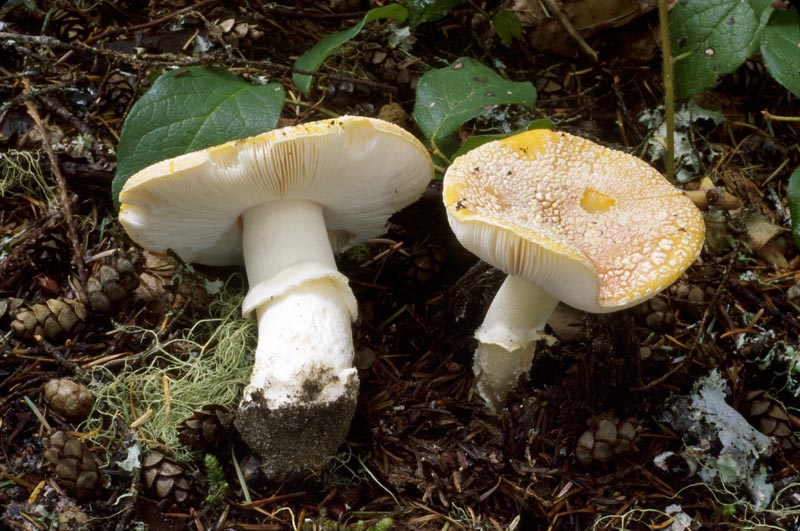
Amanita aprica © Steve Trudell
Amanita pantherina/gemmata group
-
These similar mushrooms can also be found in spring and fall, have
yellow or brown caps (a slightly different shade of yellow than A.
muscaria and A. chrysoblema sometimes have) and a
collar volva instead of concentric rings. We do not have either of these
European mushrooms in the PNW (neither A. pantherina nor A. gemmata),
but here's what I have been able to determine about what species we do have.
It
should be noted that a recent European study showed that A. gemmata may
actually just refer to A. muscaria, so even in Europe they may start
calling their yellow 'gemmata' species A. junquillea.
Amanita pantherinoides WA
(=ameripanthera n.p.)
Traditionally, it was thought that brown capped species were the "panther"
species, and yellow capped species were the "gemmata" species (covered next), but
that's not the way it works out for the two most common species in the Seattle area.
Amanita pantherinoides is yellow to brown, stocky, with persistent warts on
the cap. Our most common "gemmata" species, Amanita pacificogemmata
n.p., below, is
usually yellow, slender, and has warts that easily wash off,
although some of our less common "gemmata" species might be confused with
yellowish A. pantherinoides.
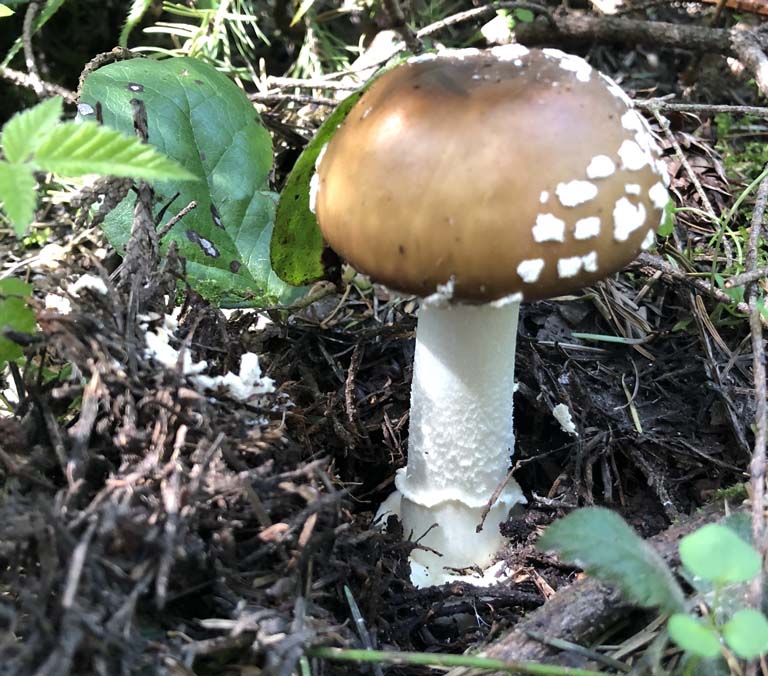

Amanita pantherindoides © iNaturalist users loather and cyndean
In Mycologia Volume 4 from 1912, Murrill listed all the known Amanitas on
the west coast. Not a lot was known back then, so there are of course many
species missing, but I imagine it is likely that the species he does include are
common species here. Here are the species he described from Seattle that could
represent A. pantherina/gemmata type species:
A. praegemmata - cap only to 6cm, persistent warts, honey-avellaneous
(grey- to pinkish- brown) to dark honey on the margin, white partial veil, stem
1.5cm thick, volva attached rim.
A. pantherinoides - cap thick, small numerous warts, honey
to dirty cream with brown center, white partial veil, stem 2cm thick, volva
entire or undulate free rim
A. umbrinidisca - cap fleshy drying thin, large irregular
patches, honey to straw w/umber disc, white partial veil, stem 1-2cm thick,
volva sub-entire free rim
In 1977, Jenkins studied the types microscopically and synonymized A.
pantherinoides and
A. praegemmata, saying they were likely the same thing, our local
panther species, with A. pantherinoides being the older name (it was
published one paragraph earlier than A. praegemmata). He did not even
consider A. umbrinidisca, because he thought it represented a very
different kind of Amanita, but subsequently, others have figured it probably is
similar to, if not the same species as the others. When we sequenced a couple
dozen or so Seattle area A. pantherina like species, they were all the
same species (we only have one common species).
What does this mean? If we assume that Murrill did not find something
exceedingly rare that has not been found since (and at the same time somehow
avoided finding the very common species), and if we assume that Jenkins was right
and at least two of his species are the same, I believe Amanita
pantherinoides is the correct name for our
common local panther species.
I
cannot rule out the fact that one of Murrill's species might be a local gemmata-like
species. One is very common, so why doesn't it appear in
his list? Another theory is that "stocky gemmata CA01" might be A.
umbrinidisca.
But for now many in the mycological community have decided to assume that all three are
the same and they refer to our panther-like species.
Amanita ameripanthera is another name that is being put forward for our
common local species, based on the fact that it is often dark brown instead of
the "honey-avellaneous" and "honey to dirty cream" that was in the Murrill's
descriptions. But there was a wide variety of cap colours in our sequences, from
yellow to brown, and they all sequenced the same, so this appears to be another
case of cap colour not being critically important. This would mean that A.
ameripanthera does not represent a unique species and the name would not be
needed.
Amanita pacificogemmata n.p. -
Our most common "gemmata-like" species in WA, this species is always yellowish, usually slender and
the warts wash off pretty easily, although occasionally it can be
stockier like A. pantherinoides. It is a sister species to a California
species, Amanita breckonii, differing by about 4 bp and 7 indels (a
couple of them being chunks of indels). I
have no evidence yet of sequences that match CA A. breckonii exactly
being found in the PNW.
Amanita pseudobreckonii n.p.
- another yellow, slender species with warts that easily wash off in the
gemmata-pantherina
group found commonly in Oregon and California. It is very difficult to tell apart from
A. pacificogemmata. It has now been found near Victoria, BC, so
you can't assume that all collections north of OR are A. pacificogemmata
n.p.
Amanita 'gemmata CA01'
("stocky") - is usually (but not always) stocky like Amanita pantherinoides
but consistenly bright yellow. It often has warts on the cap and
usually has at least somewhat of a collar volva.
One theory is that Amanita umbrinidisca refers to this.
Amanita CA06 - another
stocky species.
California has additional "panther-gemmata" species in their rich oak forests
and other habitats that aren't present in the PNW, making identification for
them even more difficult than for us.
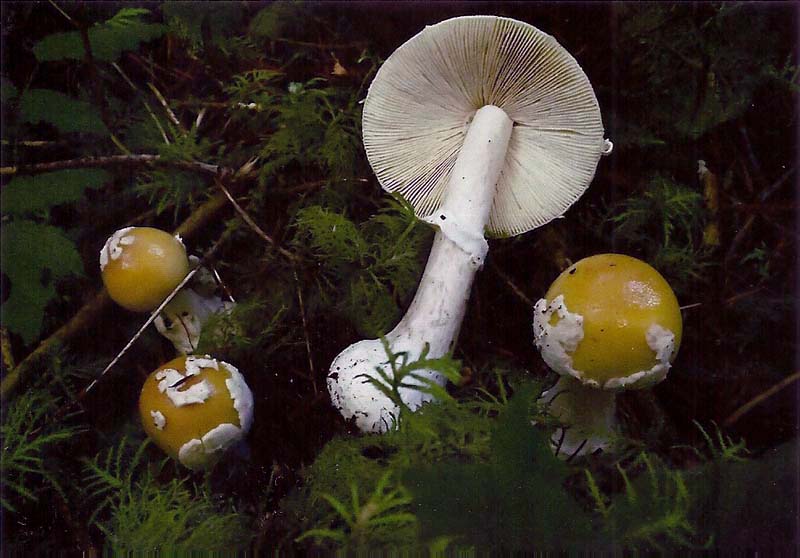

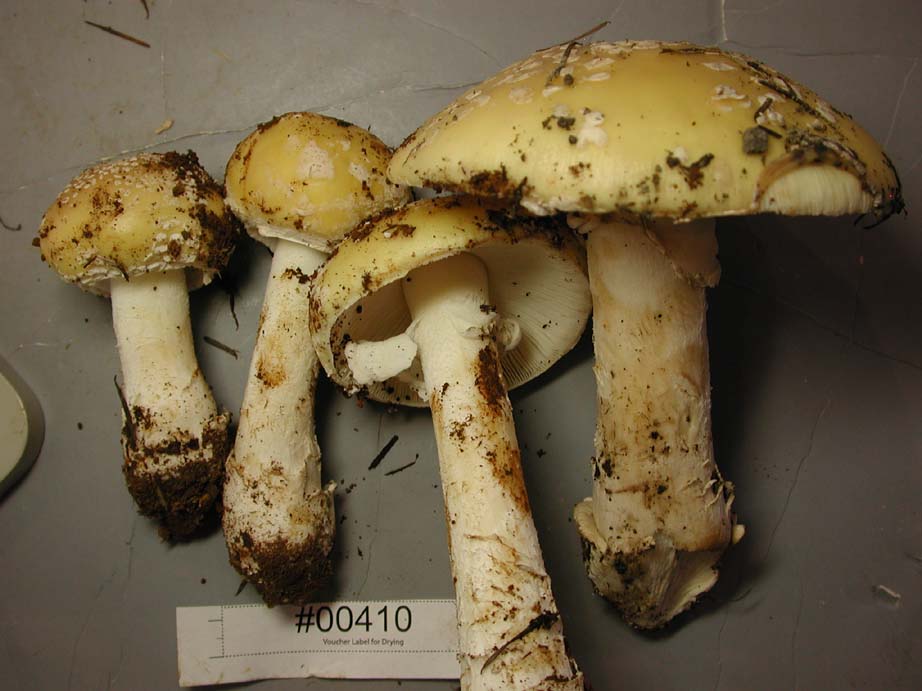


Amanita pacificogemmata n.p. © Buck McAdoo, Amanita pseudobreckonii n.p. © Corinne Srsen, Amanita 'gemmata
CA01' ("stocky") © NAMA
and the Field Museum of Natural History, A. CA06 © Drew
Henderson and Yi-Min Wang
Amanita alpinicola MT -
This species is stocky, pale yellow
and grows in spring under 5-needle pines. It has a collar volva
and also has fused warts that looked like they were ironed into the cap.
It's often found partially buried. It was described from Montana and
the DNA has been found in Idaho, as well as in WA north of Spokane at 5500' in
July. There are reports that it may be in BC and OR as well, presumably inland
and at elevation.

Amanita alpinicola © Janet Lindgren
Amanita aurantisquamosa ID -
This tan coloured species has hints of orange in the scales,
irregular patches of veil on the cap and a volva that is somewhat
sac-like at first but soon breaking up. It is
rare, only known from Southern Idaho
and we do not have any sequences of it yet.
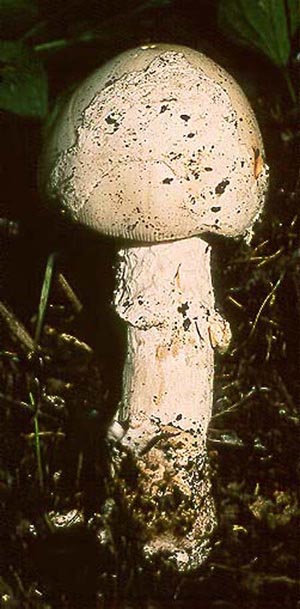
Amanita aurantisquamosa © Ellen Trueblood

 Amanita section Vaginatae
- click to expand
Amanita section Vaginatae
- click to expand
 Amanita section Phalloideae - click to expand
Amanita section Phalloideae - click to expand
 Amanita section Caesareae - click to expand
Amanita section Caesareae - click to expand
 Amanita section Validae - click to expand
Amanita section Validae - click to expand
 Amanita sections Lepidella and Saproamanita - click to expand
Amanita sections Lepidella and Saproamanita - click to expand
 Amanita section Amanita
- click to expand
Amanita section Amanita
- click to expand
 Limacella - click to expand
Limacella - click to expand